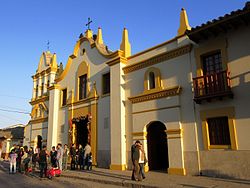Bojacá is a municipality and town of the Western Savanna Province, Colombia in the department of Cundinamarca. The urban centre is situated at an altitude of 2,598 metres (8,524 ft) on the Bogotá savanna at 40 kilometres (25 mi) from the capital Bogotá. The municipality borders Zipacón, Madrid and Facatativá in the north, Madrid and Mosquera in the east, Soacha and San Antonio del Tequendama in the south and Tena, La Mesa and Zipacón in the west.[1]
Bojacá | |
|---|---|
Municipality and town | |
 Church of Bojacá | |
 Location of the municipality and town inside Cundinamarca department of Colombia | |
| Coordinates: 4°44′1″N 74°20′32″W / 4.73361°N 74.34222°W | |
| Country | |
| Department | |
| Province | Western Savanna Province |
| Founded | 16 October 1537 |
| Founded by | Gonzalo Jiménez de Quesada |
| Government | |
| • Mayor | Juan Carlos Gaitán Chiriví (2016–2019) |
| Area | |
| • Municipality and town | 109 km2 (42 sq mi) |
| • Urban | 40 km2 (20 sq mi) |
| Elevation | 2,598 m (8,524 ft) |
| Population (2015) | |
| • Municipality and town | 11,254 |
| • Density | 100/km2 (270/sq mi) |
| • Urban | 9,256 |
| Time zone | UTC-5 (Colombia Standard Time) |
| Website | Official website |
Etymology
editThe name Bojacá comes from Chibcha and means "Purple enclosure".[1][2]
History
editThe area around Bojacá was inhabited at least since 3410 years BP (1400 BCE), evidenced by archaeological excavations from the Herrera Period performed in Aguazuque, Zipacón and around Lake Herrera, Mosquera.[3] The territories were already important in the times before the Spanish conquest when Bojacá was part of the Muisca Confederation; a loose confederation of rulers of the Muisca.
On his expedition to El Dorado and after conquering the Muisca, conquistador Gonzalo Jiménez de Quesada founded modern Bojacá on October 16, 1537.[1]
Economy
editMain economical activities of Bojacá are agriculture and livestock farming. Among the agricultural products cultivated are potatoes, carrots, maize, lettuce and fruits as blackberries, strawberries, prunes and the typical Colombian fruits uchuva, tree tomato and granadilla.[1]
Climate
edit| Climate data for Bojacá (Acapulco), elevation 2,650 m (8,690 ft), (1981–2010) | |||||||||||||
|---|---|---|---|---|---|---|---|---|---|---|---|---|---|
| Month | Jan | Feb | Mar | Apr | May | Jun | Jul | Aug | Sep | Oct | Nov | Dec | Year |
| Mean daily maximum °C (°F) | 16.1 (61.0) |
16.1 (61.0) |
16.0 (60.8) |
16.0 (60.8) |
16.1 (61.0) |
16.1 (61.0) |
15.7 (60.3) |
15.8 (60.4) |
16.3 (61.3) |
16.0 (60.8) |
16.0 (60.8) |
15.9 (60.6) |
16.0 (60.8) |
| Daily mean °C (°F) | 13.0 (55.4) |
13.2 (55.8) |
13.2 (55.8) |
13.4 (56.1) |
13.4 (56.1) |
13.1 (55.6) |
12.7 (54.9) |
12.9 (55.2) |
13.0 (55.4) |
13.1 (55.6) |
13.1 (55.6) |
12.9 (55.2) |
13.1 (55.6) |
| Mean daily minimum °C (°F) | 9.5 (49.1) |
9.3 (48.7) |
9.8 (49.6) |
10.1 (50.2) |
10.2 (50.4) |
9.9 (49.8) |
9.3 (48.7) |
9.4 (48.9) |
9.7 (49.5) |
9.7 (49.5) |
9.9 (49.8) |
9.5 (49.1) |
9.7 (49.5) |
| Average precipitation mm (inches) | 43.4 (1.71) |
54.8 (2.16) |
77.4 (3.05) |
111.9 (4.41) |
87.8 (3.46) |
44.5 (1.75) |
38.4 (1.51) |
35.1 (1.38) |
63.1 (2.48) |
105.3 (4.15) |
91.3 (3.59) |
70.9 (2.79) |
778.2 (30.64) |
| Average precipitation days | 7 | 7 | 11 | 13 | 12 | 10 | 10 | 9 | 10 | 13 | 12 | 9 | 115 |
| Average relative humidity (%) | 90 | 90 | 91 | 93 | 92 | 92 | 91 | 91 | 91 | 91 | 92 | 91 | 91 |
| Source: Instituto de Hidrologia Meteorologia y Estudios Ambientales[4] | |||||||||||||
Gallery
edit-
Central square
-
Church of Bojacá at the central square
-
Buste of friar Diego Francisco Pinilla at the central square
References
edit- ^ a b c d (in Spanish) Official website Bojacá Archived 2017-10-11 at the Wayback Machine
- ^ (in Spanish) Etymology municipalities Cundinamarca - El Tiempo
- ^ Correal Urrego, Gonzalo (1990), Aguazuque: Evidence of hunter-gatherers and growers on the high plains of the Eastern Ranges (PDF) (in Spanish), Bogotá, Colombia: Banco de la República: Fundación de Investigaciones Arqueológicas Nacionales, pp. 1–316, retrieved 2016-07-08
- ^ "Promedios Climatológicos 1981–2010" (in Spanish). Instituto de Hidrologia Meteorologia y Estudios Ambientales. Archived from the original on 15 August 2016. Retrieved 17 June 2024.


